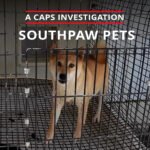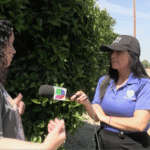Breeder: Yoder, Clayton and Laura
Address: 1825 Angle Rd SW
City, State Zip: Kalona, IA 52247
Year: 2006
USDA License: 42-A-1000
Date of CAPS Investigation: 2006-07-27
On the premises at the time of investigation: approximately 126 dogs and 18 puppies.
Breeds: Dachshunds, Pugs, Boston Terriers, Cavalier King Charles Spaniels, Chihuahuas, Shih Tzus, Yorkshire Terriers, Japanese Chins, Poodles, Jack Russell Terriers
Breeder building
There were two kennel buildings at this facility. One building had two rows of indoor/outdoor enclosures on each of two sides. One row of eight enclosures was set above another row of eight enclosures on each side. A metal gutter at one upper corner of the building was disconnected at its joint (3.1(a)-Structure; construction).
Each enclosure consisted of a treated wire outdoor cage connected to an indoor cage via a dog door. The indoor cages were made with a treated wire door and flooring and plastic walls. Water spigots were plumbed into the cages, and plastic self-feeders were attached to the inside cage doors.
Each outdoor cage was about 2.5 feet wide and high and three feet long. The indoor cages were each about 2.5 feet cubed. There were three adult dogs of various breeds per cage.
Plastic sheeting was beneath each row of enclosures to catch feces and debris. Feces and hair had accumulated in pools in the grass and rocks around the building as if it had been washed there (3.1(f)-Drainage and waste disposal); (3.11(a)-Cleaning of primary enclosures)
Flies were inside and around the kennel (3.11(d)-Pest control).
The surfaces of the indoor cages had a dirty build-up on them, especially on the floors (3.1(c)(2)-Surfaces). Some of the floors showed more than a day’s accumulation of feces (3.11(a)-Cleaning of primary enclosures).
A strong ammonia odor was in the air inside the building (3.2(b)-Ventilation).
Whelping building
The other kennel structure was a whelping building with about 12 indoor/outdoor enclosures. The outside cages were constructed with untreated, thick-gauge wire and had treated wire floors. Each cage contained two dogs of various breeds.
There was several weeks’ accumulation of feces piled underneath the cages, attracting a large amount of flies (3.11(a)-Cleaning of primary enclosures); (3.11(d)-Pest control).
A PVC pipe delivered water for all of the dogs. The water appeared dingy, and the inside of the pipe was covered in algae and a brown residue (3.11(b)(2)-Sanitization).
Inside this kennel was a row of three whelping cages on each of the longer sides of the building. These cages, which housed nursing mothers and puppies, were installed above the indoor sections of the indoor/outdoor enclosures.
The whelping cages were about three feet wide and 1.5 feet high and long and were made entirely of treated wire. The nursing mothers in the whelping cages lacked six inches of space between the tops of their heads and the tops of their cages (3.6(c)(1)(iii)-Primary enclosures). One of the cages contained a whelping Jack Russell mother that was about a foot long from the tip of her nose to the base of her tail, and two nursing puppies that were each about eight inches long from the tips of their noses to the tips of their tails (3.6(c)(1)(i)-Primary enclosures).
One cage that housed a whelping Chihuahua mother and three puppies had half of its roof slanting inwards several inches into the pen (3.1(a)-Structure; construction).
The Chihuahua puppies in this cage were in a plastic tub with a low lip that allowed them to crawl out to their mother. It appeared that the puppies’ legs were small enough to protrude through the wire flooring (3.6(a)(2)(x)-Primary enclosures).
Plastic self-feeders and water spigots were attached to each cage. The PVC piping that framed the wire under each cage was covered in fecal stains, as were plastic sheets under the cages to catch debris (3.1(c)(3)-Surfaces).




